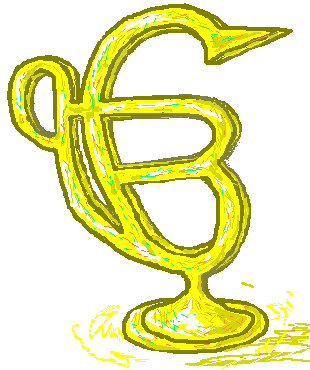

| Sikhs worship in a gurdwara. Some are simple and some elaborate, the most elaborate arguably being the Golden Temple in the Punjab where the first reading of the Guru Grath Sahib (the main scriptures containing hymns written by human Gurus and by Hindu and Muslim saints) took place. All gurdwaras have a flagpole outside and a new flag called the nishan sahib, containing the Khanda symbol, is raised every spring after the flagpole has been taken down, washed and put back up with the old flag disposed. The circle on the Khanda is a reminder that there is one God with no beginning or end and the sword in the middle stands for justice and freedom. The swords on the outside stand for steadfastness in life and beliefs. Inside, the building has a diwan hall for worship and a langar hall for sharing food. At the end of the diwan hall is a raised platform with cushions on to which the Guru Granth Sahib is placed. It is situated under a canopy. As well as these rooms there is a kitchen and a shoe room, the latter part for respect (as is head-covering and having a daily bath or shower). There may be other rooms too, such as for classes, for a library and for administration. |
| Learning for all ages takes place at the gurdwara. This includes learning about the faith and learning Punjabi. Music education is important, for the singing of the hymns and for both playing the accordian and tabla or drums. There can be clinics, youth clubs and women's societies. There can even be rooms to stay in for travellers. |
| Sewa is the duty of helping others, and Sikhs do this within the gurdwara, such as helping out in the langar or kitchen. People who cook and help are called sewardars. Giving help and receiving help are part of the way through lives before coming to meet God. As well as bowing to the Guru Granth Sahib, entrants to worship can give financial offerings. After a service karah pashad is handed out, a sign of equality through sharing of food from the kitchen. Then there is a meal after a service, and it is free, paid for by offerings within the service. Food from the langar is vegetarian (though Sikhs can eat meat). |
| In the gurdwara the Guru Granth Sahib is brought out in the morning to the diwan hall for the service; when it is put away it is done so with a short service. It is an honour to carry the book. Usually a main service takes place at a gurdwara on Saturday or Sunday although there is not a holy day as such. There may be evening prayers in the week. The service is taken by a granthi (male or female - they're equal), who can be anyone respected, waving a fan over the book as a sign of respect for its teachings. Interpretation comes from a trained giani, who also advises about ethical behaviour. Hymns sung by musicians or ragis are called kirtan. Men and women may sit together, or men on one side of the aisle and women on the other, sitting on the floor. Feet must not face the holy book. Services can last a long time, even up to five hours, so some people come and go during them. Punjabi is a key language of a service, so those people who do not already speak it attempt to learn the language. |
| Special services are held at gurpurbs, when the lives of the Gurus are celebrated. There might be a continuous reading of the Guru Granth Sahib, which may last two full days. |
| Baby naming happens by opening the Guru Granth Sahib randomly. The first letter of the baby's name is taken from the first letter on the page. |
| In a marriage ceremony the couple walk around the Guru Granth Sahib to the music of ragis singing special hymns. At the fourth encirclement, the two are married. |
| Sikhs can worship anywhere, so long as it contains the Guru Grath Sahib or a book of extracts from it. Often a room at home is set aside for the Guru Grath Sahib. There a Sikh can meditate on the Names of God and give prayers in the morning and the evening. There may be a Gutka, a book of extracts from the main holy book. |

Adrian Worsfold
Pluralist - Liberal and Thoughtful